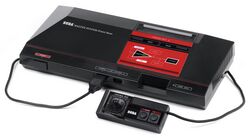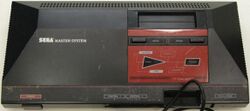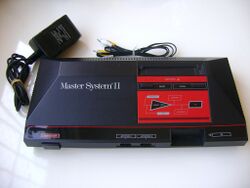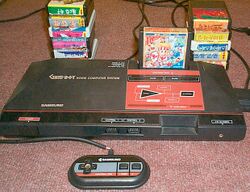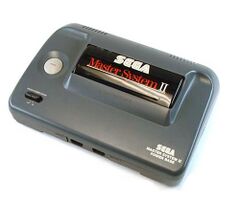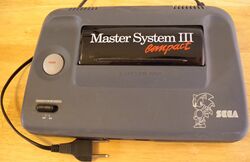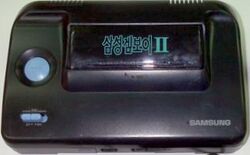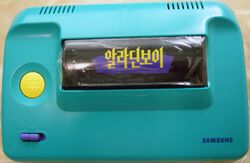Sega Master System
From Sega Retro
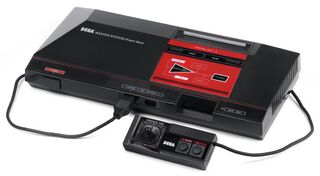
| ||||||||||||||||||||||||||||||||||||||||||||||||||||||||||||||||||||||
| Sega Master System | ||||||||||||||||||||||||||||||||||||||||||||||||||||||||||||||||||||||
|---|---|---|---|---|---|---|---|---|---|---|---|---|---|---|---|---|---|---|---|---|---|---|---|---|---|---|---|---|---|---|---|---|---|---|---|---|---|---|---|---|---|---|---|---|---|---|---|---|---|---|---|---|---|---|---|---|---|---|---|---|---|---|---|---|---|---|---|---|---|---|
| Manufacturer: Sega | ||||||||||||||||||||||||||||||||||||||||||||||||||||||||||||||||||||||
| Variants: Sega Mark III, Sega Master System II, Sega Game Box 9, Tectoy Master System Super Compact, Super Gam*Boy, Super Gam*Boy II | ||||||||||||||||||||||||||||||||||||||||||||||||||||||||||||||||||||||
| Add-ons: Demo Unit II, Telecon Pack, 3-D Glasses | ||||||||||||||||||||||||||||||||||||||||||||||||||||||||||||||||||||||
| Built-in games: Hang-On, Hang-On / Safari Hunt, Missile Defense 3-D, Alex Kidd in Miracle World, Sonic the Hedgehog | ||||||||||||||||||||||||||||||||||||||||||||||||||||||||||||||||||||||
|
The Sega Master System (セガ・マスターシステム) or SMS, is a cartridge-based video game console manufactured by Sega. It is a rebranding of the Sega Mark III intended for western markets, which in turn was a successor to the SG-1000 and SG-1000 II. In South Korea the Master System was distributed by Samsung and known as the Gam*Boy (겜보이) and later Aladdin Boy (알라딘 보이). It was codenamed the Sega Mark IV during development.
The Sega Master System was the first of Sega's consoles to see widespread distribution, and went head-to-head with Nintendo's Famicom/NES across the world. Though it was unsuccessful at dethroning Nintendo in Japan and North America, the Master System was able to outperform other rivals (notably the Atari 7800) in those regions. The Master System found its greatest success in Europe and South America, regions where it outsold the NES. Worldwide, it hit second place in the third generation of video game consoles, selling over 16 million units worldwide, including over 1.7 million in Japan, 2 million in the United States, 5 million in Brazil, nearly 7 million in Western Europe, and 720,000 in South Korea. This paved the way for its successor, the Sega Mega Drive (Genesis), gaining wider worldwide success.
The "Sega Master System" name is a relatively later creation, adopted towards the end of the 1980s after a release in Japan, Australia and a series of price drops and "improved" bundles forced the "Master System" name into use. During its first few years of service, the Master System was simply known as the Sega System or in some countries, just the Sega. It has also been (incorrectly) referred to as the Sega Master or Master. Depending on the package, the console may have also been referred to as the Sega Base System, Sega Super System, Sega Video Game System or Sega SegaScope 3-D System, with the console unit itself being referred to as the Sega Power Base.
Contents
Hardware
Models
- Main article: Master System consoles.
Master System
The original 1986 model Sega Master System took a radically different approach to its outward design to the Mark III, released a year prior. The main unit, commonly referred to as the "Power Base" is a black 3D trapezium with red/orange highlights, measuring 143/8 inches in width, 65/8 inches deep and 23/4 inches in height. After a one-inch base, the machine is formed upward and inward to form the cartridge slot plateau.
The Master System takes much of its design cues from the Nintendo Entertainment System (NES), released in 1983 in Japan and 1985 in the US, with detachable controllers and power and reset buttons. But like prior Sega consoles (and virtually all cartridge-based systems going forward), the Master System is a top-loading machine. It also contains a card slot for the handful of games distributed on Sega Card, and curiously, a diagram or vague instructions as to how the system works (i.e. insert a cartridge, power the system on, and use the control pads to manipulate an image on a television screen). The Master System also has a built-in "pause" button for stopping play.
The Master System is a hybrid 8/16-bit console. The Z80 is an 8/16-bit CPU, with an 8-bit bus width and using 8-bit and 16-bit registers. Its VDP is a 16-bit graphics processor, with a 16-bit bus width and using 8-bit and 16-bit registers. In comparison, the NES is an 8-bit console, with an 8-bit Ricoh CPU and 8-bit PPU graphics chip. The Master System's CPU and VDP also have higher clock rates and faster bandwidths than the CPU and PPU of the NES, and the Master System's VDP displays 16 colors per tile, compared to 4 colors per tile for the NES PPU. The Master System was thus a more powerful console than the NES.
The Master System has an introduction screen which appears each time the system is turned on (with or without a game inserted). The Sega logo slowly "slides" into view mid-screen (with accompanying sound effect), and the text "Master System" appears underneath, with the two-tone "Sega" tune also being played during this sequence.
Unlike the NES, the Master System displays an instructional screen if the system is turned on without having a cart or card inserted, though as Sega moved to using built-in software, the console instead began to automatically load the built-in game instead. Early original Master Systems also contain the "easter egg" Snail Maze minigame - these earlier revisions of the console's BIOS are known to have trouble playing some later cartridges, including games published by Codemasters and later Brazillian releases by Tec Toy.
The 1987 Japanese release, whose design was also brought to South Korea, makes a number of important changes. Aside from adjusting the the cartridge slot, it has the Mark III's FM Sound Unit built-in from the get go, and supports the 3D Glasses without the need for an adapter (which usually plugs into the card slot).
Japanese Master Systems are quite difficult to spot, even though the cartridge size is smaller. They can be identified by the text on the left hand side of the unit - Western models read "Master System/Power Base", while Japanese systems simply read "Master System".
Master Systems have an expansion slot on the base of the system, in anticipation of future add-ons should Sega choose to release some. No such peripherals were ever released, and by mid-1990 Sega had conceded that the port had no practical purpose[2].
Master System II
After a period of decline and the rise of the newly-released Sega Mega Drive, Sega constructed the Sega Master System II for overseas markets. There is virtually no resemblance to the earlier model, opting for smooth curves and rounded corners more akin to the Mega Drive, and is a great deal smaller (and, as a result, cheaper to manufacture).
The Master System II removes many features (usually unpopular ones) in an effort to cut costs. There is no card port (and by extension, no 3D Glasses support), the unused expansion port was removed and the reset button has been omitted in favour of a larger pause button. The swinging, hinged cartridge slot doors of the original model are replaced with a sliding cover (which cannot be closed with a cartridge inserted), and the number of video output options reduced (usually to just RF). Also missing is a power LED and the BIOS screen introducing the console when powered on.
Each region has its own set of cosmetic differences. In Brazil the system is known as the Master System III Compact, and in South Korea it was released twice, first as the Super Gam*Boy II and later the Aladdin Boy.
All Master System IIs either included Alex Kidd in Miracle World as a built-in game, or Sonic the Hedgehog, which arrived in 1991.
Technical specifications
Processors
- Main CPU: NEC 780C (based on Zilog Z80) [5]
- Instruction set: 8‑bit and 16‑bit instructions, 6–18 registers [6]
- Bus width: 8‑bit
- Clock rate: 3.579545 MHz (NTSC), 3.54689493 MHz (PAL/SECAM)
- CPU memory access: Z80 directly addresses program RAM and ROM, but only addresses VRAM through VDP hardware ports.[3] It can access VRAM by commanding/programming VDP,[7] or using OUTI instruction which transfers data to VRAM at rate of 291.3 KB/s (12 cycles per byte).
Graphics
- Graphics processor (GPU): Sega VDP (based on Texas Instruments TMS9918) [3][8]
- Revisions: Sega 315‑5124 / Yamaha YM2602 (Mark III, Master System), Sega 315‑5246 / NEC UPD9004G (Master System II)
- Clock rate: 10.738635 MHz
- Pixel clock rate: 5.3693175 MHz (NTSC), 5.3203424 MHz (PAL) [9]
- Bus width: 16‑bit (16‑bit VRAM bus, 8‑bit Z80/ROM bus)
- Memory bus clock rate: 5.3693175 MHz (NTSC), 5.3203424 MHz (PAL)
- Registers: 8‑bit and 16‑bit [10][7]
- Memory access: VDP directly addresses VRAM, has its own internal CRAM and sprite line buffer, and has access to cartridge ROM. It can be commanded and programmed by Z80.
- Color TV signal encoder: Rohm BA7230LS [5] / Sony V7040 RGB Encoder / Sony CXA1145 [11] / Fujitsu MB3514 [12] / Sony V7040 / Motorola MC1377 [13][14]
- Color burst clock input: 3.579545 MHz (NTSC),[5] 3.546895 MHz (PAL)
- Screen resolutions: 256x192 and 256x224. PAL/SECAM also supports 256x240.
- Refresh rate: 59.922743 Hz (NTSC), 49.701459 Hz (PAL)
- Frame rate: 59.922743 frames/sec (NTSC), 49.701459 frames/sec (PAL)
- Colors: Up to 32 simultaneous colors (16 for sprites, 16 for background) available from a palette of 64 colors (6‑bit RGB), 16 colors (4‑bit) per pixel, mid‑frame palette swap allows up to 64 simultaneous colors
- Characters/Tiles: 8x8 pixel characters/tiles, 16 colors per tile, maximum 488 unique characters/tiles on screen (due to VRAM space limitation), horizontal & vertical background tile flipping (up to 1792 flipped tiles in VRAM)
- Background: Tilemap playfield, 8x8 tiles, horizontal & vertical tile flipping, up to 448 tiles/patterns in VRAM used by background,[15] up to 1792 flipped tiles in VRAM used by background, definable priorities for individual background tiles [7]
- Sprites: Maximum 64 sprites on screen, 8 sprites per scanline, 16 colors (15 opaque, 1 transparent) per sprite, up to 256 tiles/patterns in VRAM used by sprites,[7] collision detection [16]
- Scrolling: Smooth hardware scrolling, horizontal & vertical scrolling, diagonal scrolling, line scrolling, partial screen scrolling [17]
- IRQ raster interrupt capabilities: [17] Interrupt per frame, interrupt per scanline,[7] mid‑frame palette swap, transparency effect, line scrolling, partial screen scrolling
- VDP display modes: [7]
- Modes 1–3: 256x192 resolution, 8x8 and 16x16 sprites, 16x16 and 32x32 zoomed sprites
- Mode 4: 256x192, 256x224 and 256x240 resolutions, 8x8 and 8x16 sprites, 16x16 and 16x32 zoomed sprites
- VRAM screen map: 2 KB to 2.25 KB [15]
- Sprite attribute table: 256 bytes (2 Kbits), including 64 byte tile/pattern data
- Background name table: 1.75 KB (14 Kbits) or 2 KB (16 Kbits),[7] 16‑bit per tile [17]
- 256x192 resolution: 1.75 KB, 32x28 table (256x224 pixels), 896 tiles (768 visible)
- 256x224resolution: 2 KB, 32x32 table (256x256 pixels), 1024 tiles (896 visible)
- 256x240 resolution: 2 KB, 32x32 table (256x256 pixels), 1024 tiles (960 visible)
- VDP fillrate: 5.3693175 MPixels/s (NTSC), 5.3203424 MPixels/s (PAL)
- Pixels per frame: 89,604 (NTSC), 107,045 (PAL)
- Pixels per scanline: 342
- VDP pixel bandwidth: 2.56029 MB/s (NTSC), 2.53694 MB/s (PAL)
- Pixel bandwidth per frame: 43.75195 KB (NTSC), 52.26855 KB (PAL)
- Pixel bandwidth per scanline: 171 bytes
Sound
- PSG sound chip: Sega PSG (SN76496) @ 3.579545 MHz [5][18]
- 4 channel mono sound [17]
- 3 square wave sound generator tone channels: 4–10 octaves, 16 volume levels, 1024 (10‑bit) frequencies, 122 Hz to 125 kHz frequency range
- 1 noise generator channel: White noise, periodic noise, 16‑bit LSFR, 16‑bit ring buffer, 3 preset frequencies (7.8 to 19.5 kHz), can match frequency of 3rd tone channel
- PCM/PWM sampling: Uses 3 tone channels, 1‑bit to 8‑bit audio depth, 5–64 kHz sampling rate, up to 16 KB per sample
- Based on TI SN76489
- 4 channel mono sound [17]
- FM sound chip: Yamaha YM2413 [17]
- 9 mono FM synthesis channels
- 2‑operator FM synthesis sound
- Instruments: 15 pre‑defined instruments and user‑defined sound
- Rhythm mode: 3 channels can be used for percussion sounds
- Built into Japanese Master System
- Available as plug‑in module for Mark III
- Supported by certain games only
Memory
- System RAM: 24 KB (most models) or 40 KB (some models) [19][5]
- VDP internal memory: 64 bytes (512 bits) [7]
- Color RAM (CRAM): 32 bytes (256 bits, 32x 8 bit entries)
- Sprite line buffer: 32 bytes (256 bits, 8x 32 bit entries)
- System ROM: 8 KB (64 Kbits) to 256 KB (2 Mbits), depending on built‑in game
- Cartridge ROM: 8 KB to 32 KB (Sega Card), 128 KB to 4 MB (Cartridge) [20]
- Note: Z80 can read program code directly from ROM, allowing program RAM to be used for general program data (such as state information).
- Cartridge battery backup SRAM: 8 KB (64 Kbits) to 32 KB (256 Kbits) [21]
Configuration
Bandwidth
- Internal processor bandwidth:
- Z80 internal bus: 3.41372 MB/s (NTSC), 3.382582 MB/s (PAL)
- VDP internal CRAM: 5.12058 MB/s (NTSC), 5.073873 MB/s (PAL)
- System RAM bandwidth: 10.225 MB/s
- Main RAM: 2.889922 MB/s
- VRAM: 7.335954 MB/s
- ROM bandwidth: 3.41372 MB/s (NTSC), 3.382582 MB/s (PAL)
Game slot
- Game Card slot (Mark III and original Master System only)
- Game Cartridge slot
- Japanese and South Korean consoles use 44‑pin cartridges, same shape as the SG‑1000
- Western consoles use 50‑pin cartridges with a different shape
- The difference in cartridge style is most likely a form of regional lockout
- Expansion slot
Peripherals
Internals
RF Converter: MGB3-VU3401, 8E388 PCB Component Side Markings: (c) SEGA 1988 : SEGA (R) M4 POWERBASE / NTSC 171-5533-01 : 837-6629 19 AUG 1988 CON2: 35 Pin Card Slot 209-5020 K16R CON3: 50 Pin Cartridge Slot PSB4D255-4R1 M18R CON4: 50 Pin Card Edge IC1: Zilog Z0840004PSC Z80CPU 8828 SL0965 IC2: 0821EX SEGA MPR-11460 W46 IC3: NEC JAPAN D4168C-20 8829P5007 IC4: SEGA (R) 315-5216 120U 8820 Z79 IC5: SEGA 315-5124 2602B 84 18 89 B IC6: NEC JAPAN D4168C-15-SG 8828XX215 IC7: NEC JAPAN D4168C-15-SG 8828XX215 IC9: SONY 8M09 CXA1145
SMS Control Pad Information:
- female plug on end view:
5 4 3 2 1 9 8 7 6
- pin 1: Up
- pin 2: Down
- pin 3: Left
- pin 4: Right
- pin 5: No Connection
- pin 6: Button 1 (Start)
- pin 7: No Connection
- pin 8: Common (Ground)
- pin 9: Button 2
History
- Main article: History of the Sega Master System.
Miscellaneous
Can Game Gear games be played on the SMS?
The Game Gear can run SMS carts, of course, but that is due to intentional backwards compatibility of the GG to the SMS, and such does not work in reverse. The only hardware difference known between the two on a chip level is that the GG can define 4096 possible colors, while the SMS can only define 64 colors. As the GG has more colors, it has a different method of setting each of the color registers than the SMS did: The SMS color can be determined by one byte and hence only needed one register, whereas a number from 0 to 4095 needs two bytes, and so the GG VDP has two color registers. Game Gear games which use the expanded graphics mode will run on an SMS, but with scrambled colors; the lack of a "Start" button also prevents many Game Gear games from being played. Several Game Gear games were straight ports of their SMS counterparts and will run through the use of a flash cart or homemade cartridge adapter.
Sega RGB Cable
In France, the original Master System (and the SMS II, which had the A/V port instead of RF jack) were sold with an RGB lead (model 3085). One end plugs into the SMS, the other into the SCART/Peritel socket on a TV, via a small box in the lead, labeled 'Adapteur R.V.B.'. As it utilizes RGB, it gives a sharper and more vibrant picture compared to RF or composite video. The box contains a small PCB, the purpose of which is to provide the blanking and function switching signals, so that the TV can automatically switch to RGB input.
Games
List of games
- Main article: List of Master System games.
Launch titles
Japan
- Hang-On (Sega Card)
- Teddy Boy Blues (Sega Card)
North America
United Kingdom
- Action Fighter
- Black Belt
- Choplifter
- Fantasy Zone
- Hang-On (Sega Card)
- Transbot (Sega Card)
- World Grand Prix
Magazine articles
- Main article: Sega Master System/Magazine articles.
Promotional material
Print advertisements
- MasterSystem1 UK PrintAd.jpg
UK (1)
- SpecialOffer SMS UK PrintAd.jpg
UK (2)
- SegaNumber1ForTVArcadeActionSMSUKAdvert.jpg
UK (3)
- SegaTVArcadeAction SMS UK PrintAd.jpg
UK (4)
- SegaEuropesNo1 SMS MD UK PrintAd.jpg
UK (6)
- MasterSystem UK PrintAd 1991-06.jpg
UK (7)
- SMS Plus & Golden Axe Or MJM Advert.jpg
UK (Master System II £99.99)
- SMS & SMS Plus With Alex Kidd Advert.jpg
UK (Master System II £59.99)
- SMS BR PrintAdvert.jpg
BR (Master System; 1)
- SMSII BR PrintAdvert.jpg
BR (Master System II; 2)
- SMSII BR PrintAdvert 2.jpg
BR (Master System II; 3)
- SMSII BR PrintAdvert 4.jpg
BR (Master System II; 4)
- SMS AR PrintAdvert.jpg
AR
also published in:
- S: The Sega Magazine (UK) #7: "June 1990" (1990-05-03)[32]
- S: The Sega Magazine (UK) #8: "July 1990" (1990-06-07)[33]
also published in:
- Game Power (IT) #1: "Dicembre 1991" (1991-1x-xx)[34]
also published in:
- Ação Games (BR) #2: "Junho 1991" (1991-06-19)[36]
- Ação Games (BR) #3: "Julho 1991" (1991-07-xx)[37]
Retailers
Pamphlets
Television advertisements
US (1)
US (2)
JP (1)
AU (Master System II)
KR (Gam*Boy)
External links
References
- ↑ File:ACE UK 01.pdf, page 19
- ↑ File:SegaVisions US 01.pdf, page 9
- ↑ 3.0 3.1 3.2 3.3 3.4 3.5 File:SMSServiceManualEU.pdf
- ↑ 4.0 4.1 4.2 https://github.com/ekeeke/Genesis-Plus-GX/blob/master/core/system.h
- ↑ 5.0 5.1 5.2 5.3 5.4 Sega Mark-III Hardware Notes (2008-11-14)
- ↑ 6.0 6.1 Obsolete Microprocessors
- ↑ 7.00 7.01 7.02 7.03 7.04 7.05 7.06 7.07 7.08 7.09 7.10 Sega Master System VDP documentation (2002-11-12)
- ↑ 8.0 8.1 8.2 File:SMS2ServiceManualEU.pdf
- ↑ https://github.com/mamedev/mame/blob/master/src/mame/drivers/sms.cpp
- ↑ File:SoftwareReferenceManualForSegaMarkIIIEU.pdf
- ↑ File:CXA1145P datasheet.pdf
- ↑ File:MB3514 datasheet.pdf
- ↑ Sega Master System Video Output
- ↑ 14.0 14.1 14.2 Sega Master System Documents
- ↑ 15.0 15.1 File:SoftwareReferenceManualForSegaMarkIIIEU.pdf, page 8
- ↑ File:SoftwareReferenceManualForSegaMarkIIIEU.pdf, page 6
- ↑ 17.0 17.1 17.2 17.3 17.4 Sega Master System Technical Documentation (1998-06-10)
- ↑ Sega SN76489
- ↑ 19.0 19.1 Sega Master System RAM
- ↑ 20.0 20.1 SMSARCH: A Sega Master System Cartridge Archiver
- ↑ Sega Mappers
- ↑ 22.0 22.1 File:UPD4168 datasheet.pdf
- ↑ File:KM6264B datasheet.pdf
- ↑ File:HM65256B datasheet.pdf
- ↑ File:CXK3864 datasheet.pdf
- ↑ ROM Part Numbers
- ↑ File:MB831000 datasheet.pdf
- ↑ Memory Mapper Hardware Notes
- ↑ SMS PINOUTs: ROMs (Wayback Machine: 2009-02-05 13:19)
- ↑ File:TMS27C512 datasheet.pdf
- ↑ File:AM29F040 datasheet.pdf
- ↑ S: The Sega Magazine, "June 1990" (UK; 1990-05-03), page 2
- ↑ S: The Sega Magazine, "July 1990" (UK; 1990-06-07), page 2
- ↑ Game Power, "Dicembre 1991" (IT; 1991-1x-xx), page 6
- ↑ Bestial!, "xxxx xxxx" (PT; 1993-xx-xx), page 9
- ↑ Ação Games, "Junho 1991" (BR; 1991-06-19), page 20
- ↑ Ação Games, "Julho 1991" (BR; 1991-07-xx), page 12
| Sega Home Video Game Systems | ||||||||||||||||||||||||||||
| 83 | 84 | 85 | 86 | 87 | 88 | 89 | 90 | 91 | 92 | 93 | 94 | 95 | 96 | 97 | 98 | 99 | 00 | 01 | 02 | 03 | 04 | 05 | 06 | 07 | 08 | 09 | 10 | 11 |
|---|---|---|---|---|---|---|---|---|---|---|---|---|---|---|---|---|---|---|---|---|---|---|---|---|---|---|---|---|
| SG-1000 | SG-1000 II | Mega Drive | Mega Drive II | |||||||||||||||||||||||||
| SC-3000 | Mega-CD | Mega-CD II | Genesis 3 | |||||||||||||||||||||||||
| Sega Mark III | 32X | Dreamcast | ||||||||||||||||||||||||||
| Master System | Master System II | |||||||||||||||||||||||||||
| AI Computer | Game Gear | |||||||||||||||||||||||||||
| Saturn | ||||||||||||||||||||||||||||
| Pico | Beena | |||||||||||||||||||||||||||
| Sega Master System | |
|---|---|
| Topics | Sega Master System | Technical Specifications (Hardware Comparison) | History | Boot ROM | Magazine articles | Promotional material | Merchandise |
| Hardware | Asia | North America | Western Europe | Eastern Europe | South America | Australasia | Africa Sega Mark III | Sega Game Box 9 | Master System Girl | Master System Super Compact | Kiosk | Sega System E |
| Add-ons | Demo Unit II | Telecon Pack | FM Sound Unit | 3-D Glasses |
| Controllers | SJ-152 | Control Pad | 3-D Glasses | Control Stick | Handle Controller | Light Phaser | Paddle Control | Rapid Fire Unit | Sports Pad | SG Commander |
| Misc. Hardware | Action Replay | Card Catcher | Action Case | Freedom Connection | Playkit |
| Unreleased | Floppy Disk Drive |
| Consoles-on-a-chip | Arcade Gamer Portable | TF-DVD560 | DVD Karaoke Game DVT-G100 | Fun Play 20-in-1 | Handheld Electronic Games | Master System 3 Collection | Master System 3 | Master System Evolution | Master System Handy | PlayPal Plug & Play | Poga |
- Pages with broken file links
- JP Master System hardware
- US Master System hardware
- DE Master System hardware
- FR Master System hardware
- UK Master System hardware
- IT Master System hardware
- AU Master System hardware
- MX Master System hardware
- AR Master System hardware
- BR Master System hardware
- KR Master System hardware
- AS Master System hardware
- ZA Master System hardware
- Master System hardware
- External source code references
- GalleryPrintAd file defined
- Sega Master System
